A Visit to the High End 2019 show in Munich
Visitor: Carlo Iaccarino
The show took place from May, 9th through May, 12th, 2019 at the M.O.C.
facilities, in Munich, Germany
Originally written: May, 2019
Website with plenty of resources: High
End Society
Foreword
Here I am, again, enjoying my annual escape to the High End Show in
Munich.
Once again, let me point you to the forewords of my 2014, 2016, 2017 and 2018
pieces.
This year, I immediately noticed a change in pace, starting from the press
conference.
The presentations were shorter, more informal. Everyone spoke standing, not
seated behind a long table, and made a quick keynote showing just data that
demonstrated growing trends in exhibitors (551, against 530 in 2018) and
exhibition spaces (223 closed spaces against 198 in 2018). They also
insisted that they won't move from the M.O.C., with which they signed an
agreement also for next years. Yet, they also said that they
were looking forward to the completion of the automotive exposition spaces
in front of the buildings presently used, whose construction works, unlike
what I previously thought, were still in progress.
Much emphasis was given, instead, to the collateral projects held by
the H.E.S.
One was the education and formation program for certified
dealers/installators, albeit aimed only at the internal German
market.
Another one was their co-operation with Dynaudio for the UNheard
project.
Selected independent and not (yet) famous artists (30, for now) were granted
the possibility to record their performance in a real recording studio, with
top-notch gear and highly qualified sound technician; moreover, the total
ownership of the rights from the resulting records belonged only to
the recorded artists.
H.E.S. and Dynaudio used a mobile recording studio built inside a container,
with one transparent side wall, so that people from outside can watch the
recording sessions and enjoy the music of those unfamiliar artists. During
the show, this mobile studio was up and running, parked in the MOC's inner
area where the biergarten is - it can't have been an easy task to squeeze it
in. Unfortunately, the rainy weather prevented a packed audience from
attending the performances... Anyway, on the web you can find a collection of
videos illustrating the project and the recordings.
This year, H.E.S. has chosen Steven Wilson as the show's testimonial, or
brand ambassador, as they say.
He is a talented and worldwide appreciated prog-rock musician,
although he told us he hates this label, mainly because he hates to label
the music by genre.
He also recently gained fame as a re-mixer of iconic albums by King Crimson,
Yes, Jethro Tull and others.
He underlined that his work, in this case, was to re-mix, not to re-master,
the old tapes. He pays a lot of attenton to not applying a global EQ or to
play with the record's dynamic. He, rather, works on the raw
multitrack tape and, with the latest technology he has access to, mixes the
tracks again, trying to bring to light some particulars that were not so
illuminated in the previous versions. He added also that he hates the
present way of thinking in the mastering business, where the master is
produced aimed at a particular user (a master for a piece of music thought
to be mainly heard in cars, another one for music whose producer think will
mainly be heard by internet, and so on). He said that when he's done a
remix, there's almost never a mastering process and the final mix, being
what he likes to hear, is the final version that you will find on CDs or as
a file to download, and that will also be the version that, for instance,
the radio will play (albeit radios usually apply their own eq and
compression, but this remained untold...).
Another very interesting piece of news came from the "S
ounds Clever" project.
H.E.S. challenged exhibitors to setup well sounding systems for under Eur
5.000, clearly to attract more people and convince them that they don't have
to spend a fortune to take home the real HiFi experience. It's not a brand
new idea - I remember something similar made years ago during a USA audio
show, RMAF, if I'm not goofing - but I think it's something worth pursuing
and a good signal from an industry usually seen aimed just at bored rich
(male) adults.
Now, I know that this is a sum that many of us find already intimidating,
but consider a couple of things.
First, 5K is the UPPER limit of the system cost, and several of the
suggested systems were actually under this price point.
Second, there were 18 (19, according the website) systems proposed by
different exhibitors (mainly distributors, easily the ones most able to
conceive a bundle offer with gear from different brands), and some of them
were, in a sense, modular, so that you could start with the essential
pieces you mainly like (e.g., a simple headphones and can amp combo) and
eventually add later the other pieces (turntables, digital file players,
etc.).
Finally, although 5K isn't exactly cheap, the idea was to show that a high
level of QUALITY could be within reach - not an easily affordable commodity,
but something reachable, with the effort that good things often ask (and
deserve).
And then... hey, the show itself is called High End :-)
The last thing from which I felt this new shift in the show's organization
was the advertising campaign.
This year I saw advertisement of the show in much more places, and with an
effective appearance.
Here's what could be seen at no less than the airport!
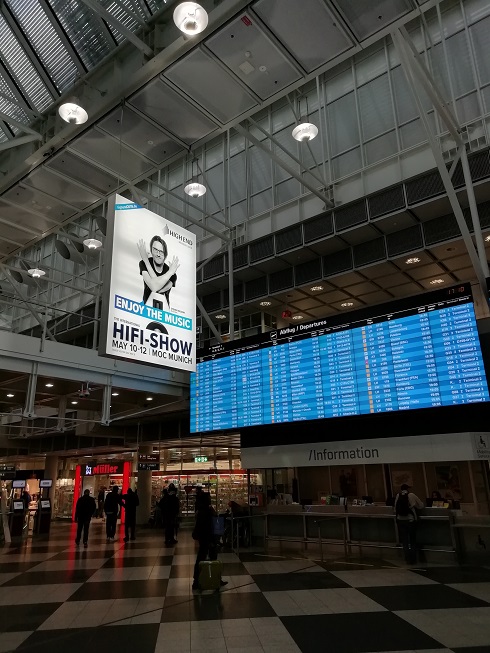
And that is a summary of the several visual advertising for this year,
placed on the streets, highways, railways, etc.

All in all, a very effective campaign. I really had the feeling of a
stronger visibility, this year; and closer to the common
people rather than to us - I may be wrong, but I think this is the
first year that there is a big "hi fi show" moniker, clearly
responding to the question: "High End: what's that?" that
people could ask themselves when reading the ads and not previously knowing
anything about it.
Lastly, let me repeat my usual, but always necessary, remark.
As I always stated clear, I'm not a professional journalist, and what I
write are simply my thoughts, my attempt to get you to stroll with me along
the shows aisles, halls and booths, like friends attending the show
together. For your (our) luck, there were many, many real journalists
from every corner of the world at the show, and you can find lots of very
professional and complete real reports on the various magazines and
websites, with lots of professional photos and even with lots of video
footages. I think that those reports deserve great respect, since I saw the
hard work with which they were being made, and, as you, I'm looking forward
to reading and watching them.
Is there life under 5K?
As I said, I think that one major feature of this year's show was the
Sounds Clever suggestion of sub-5.000 Euro systems ready to produce
good quality music.
Therefore, here is what I could find about it. It's not a complete review of
all the systems. For some exhibitors didn't take it that seriously, and
appeared on the group with the list of the gear composing the proposed
system, but didn't have those systems ready and playing; others, I simply
didn't have the time to find them or to listen to them, since I could not
manage to arrive during the limited time when they demonstrated their
systems. Anyway, here's what I've seen.
This was the system proposed by The High End Company, distributor of Totem Acoustics, for EUR 2.129
(I'll generally show all prices with 19% German VAT).
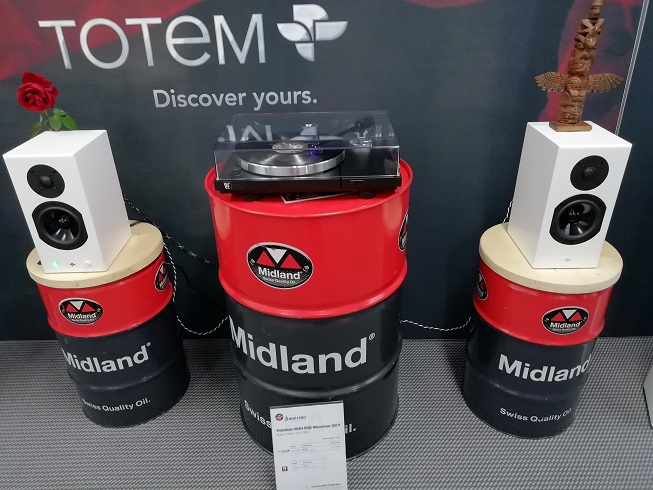
The system consisted of the new KIN PLAY active loudspeakers, that
can accept analog input signals (RCA or 3.5 mm jack) and digital input
signals, either wired (optical - up to 24/192) and wireless (Bluetooth
Apt-X); completed with the KIN SUB subwoofer; plus accessories (power
cord for one loudspeaker, speaker cable to connect it to the other
loudspeaker, optical cable, remote control, rubber feet). You can start
playing music from your smartphone streaming from a web service, like Tidal,
and from the TV connected via optical cable (consider that many modern
smart TV sets can actually play files from your home network...), and
then add an analogue source (in that case, a turntable with built-in
pre-phono).
A different approach come from Naim, that, for Eur 1.199, proposed
its acclaimed all-in-one streamer/player mu-so (albeit not the newer
version... maybe that is the price "until current stock sold",
although it didn't seem exactly a bargain).
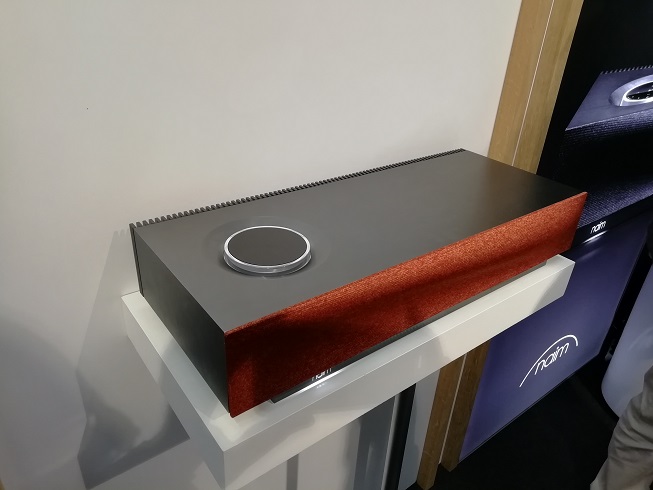
Maybe more interesting was the system proposed by Reson
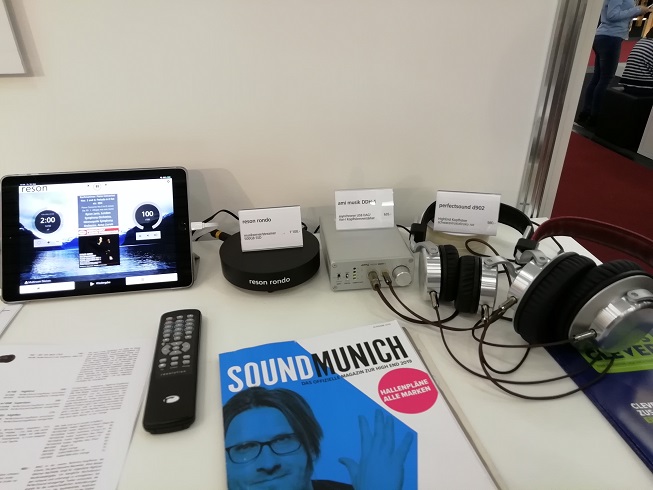
For Eur 2.715, it included their little Rondo music server/streamer
(the... round puck you see near the tablet on which its commanding
proprietary app is running), the AMI DDH-1 DAC/can amp/preamplifier
and the PerfectSound d902 headphones (in my photo you see two of
them, simply because this model comes with TWO interchangeable pair of
ear-pieces for different usage). This was a system that, for me, gave a good
sense of value, and a fair amount of contemporary quality audio technology.
This, too, was a system that could be easily upgraded, since the DDH-1
sports also an analogue input (3.5 stereo jack) and an analogue output to
which you can connect a pair of active loudspeakers, or a stereo power amp
or an integrated amplifier (the output can be set to fixed level) to drive a
pair of passive speakers).
A much more traditional proposal by the Polish manufacturer Taga Harmony. For Eur 3.591 they
proposed their HTA-1200 hybrid (12AX7/12AU7) stereo (80 W/ch/8 Ohm)
integrated amplifier, with phono (MM/MC) and digital (coax/optical, up to
24/192) inputs and headphone output, plus the DA-300 PCM and DSD USB
DAC (Sabre ES9018K2M), and the Platinum B.40 bookshelf loudspeakers; the
price included the cabling (USB, interconnects and loudspeaker cable, power
cable with filter) and, to make things more unusual and interesting, the
sound diffuser that you see in my picture.
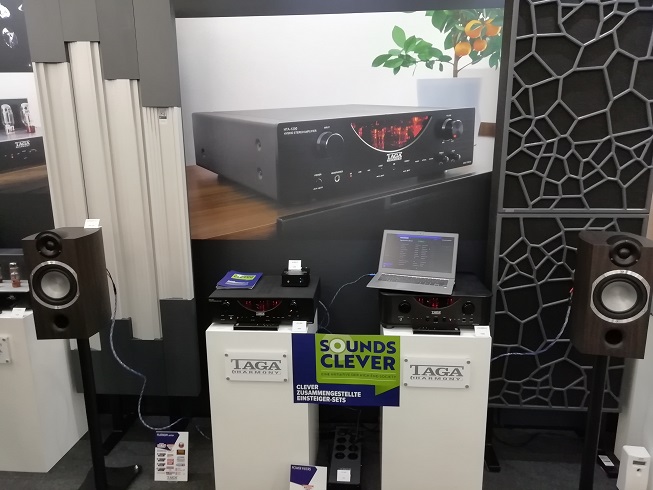
Another traditional proposal came from SVS, an USA brand that gained popularity
with their subwoofers and now known also for their loudspeakers.
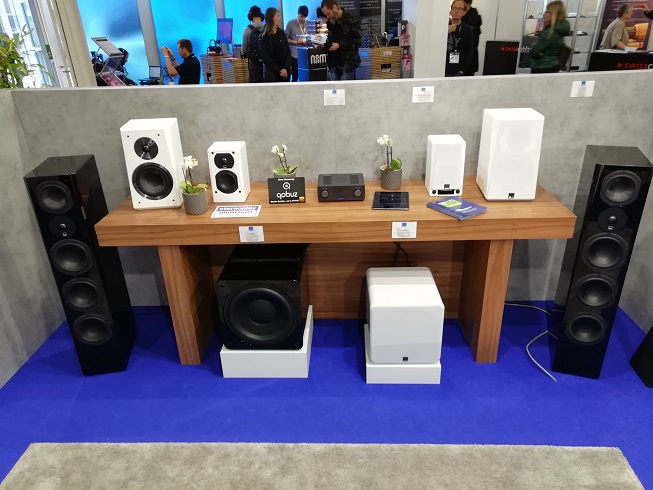
For Eur 4.624, the system consisted of the Prime Pinnacle
floorstanding loudspeakers and the little but powerful (800 W)
SB-3000 active subwoofer (the black one in the picture) regulated by
an internal DSP commanded by an app to download onto your smartphone.
All this was driven by the Prime wireless SoundBase, a device (in my
picture, the two-knobbed box between the flowers on the table) that includes
a stereo amplifier (300 W/ch), a DAC (192/24), with analog inputs (RCA and
3.5 stereo jack), digital input either wired (optical, ethernet) and
wireless (WiFi, Bluetooth Apt-x), a line level, a subwoofer output and a
headphones output.
I heard the system playing songs streamed from Qobuz and, considering the
open and busy space, it was promising. More interesting, I think that they
included the subwoofer more as a tribute to their fame than as a required
component, since the sound was good even with the sub turned off, a switch
that can save you Eur 1.500; and in time, you can add the sub next Christmas
;-).
Half-way between tradition and modernity, the system proposed by PRO-JECT consisted of an
X2 (their website lists only an X 1 model...) belt driven
turntable, with pre-mounted Ortofon-derived MM cartridge and a DS2T
stream box. Those sources fed a Maia DS2 >100 W/ch stereo
integrated amplifier with MM/MC phono input, analogue inputs, wired and
wireless digital inputs (up to 24/192 PCM and DSD 256) that, in turn, drove
a pair of 15DS2, floorstanding loudspeakers. All this stuff, cabling
included, was proposed for Eur 4.650; of course, also with this system you
can start just with your smartphone connected via Bluetooth Apt-X (or your
PC connected via USB) to the amplifier and the loudspeakers, for about half
that price; or even less, if you happen to have a spare pair of headphones
:-) And then add more year after year...
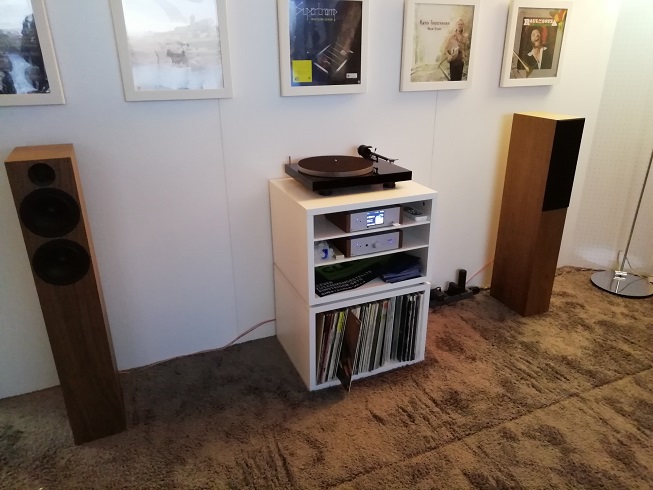
I want to express my appreciation for this proposal. It showed the exhibitor
really cared about the task, and hadn't just filled a list of its less
expensive components. The system was properly setup into the same closed
space into which big and powerful Cabasse loudspeakers were also demoed,
thus maximizing the efforts to set up a good environment. Moreover, the
sound was pleasant and, if something needed improvement, it would have been
on the turntable/cartridge side, whose sound was strangely not as good as
the digital playback in that system. Finally, there were scheduled times to
audition the system and they were respected, no matter how many people were
coming to the booth just to listen to the bigger and better Cabasse
system... and these people ended up listening also to that (much) less
expensive combo.
Another traditional system, but much less expensive, was proposed by Indiana Line's German
distributor. For Eur 1.800 the system consisted of CD-Player and integrated
amplifier (2 x 50 W, Bluetooth and USB digital inputs) by Vieta from
Spain and a pair of 3-way Tesi 561 floorstanding loudspeakers by
Indiana Line.
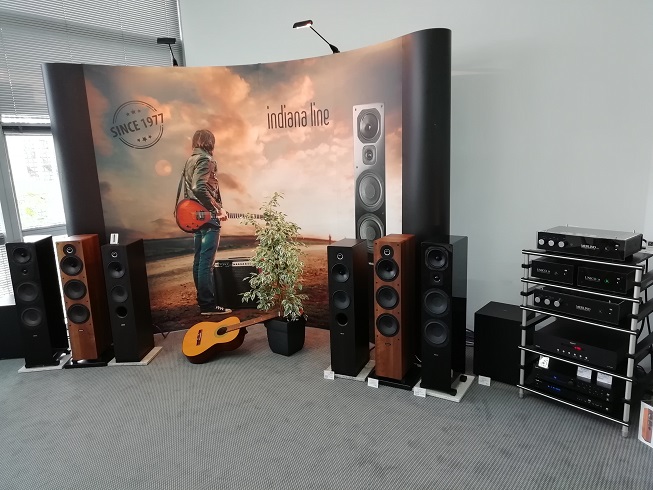
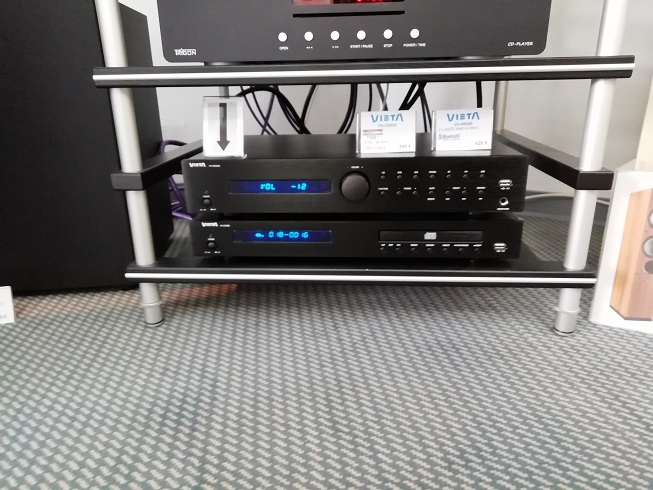
The sound of this system seemed to me a little "loudness-like",
yet I must admit it was pleasant to listen to and, above all, catching, toe
tapping. Maybe it was also a matter of the music played, but I had the
impression that this system worked as it should have: an attraction for
those who may be interested in domestic music playback but cannot count on
big finances, like we all were during our youth... ;-)
The system proposed by the Japanese STAX for Eur 2.700 consisted of
their SR-L 700 Pro electrostatic headphones driven by their
SRM-D10 portable DAC/amplifier. I quite couldn't get the sense of
providing a mobile amplifier, since this combo dimensions and weight
didn't seem to me the most comfortable to carry with you while strolling
around. Yet, its sound was really pleasant to these incompetent ears, so
maybe it can be a neat music-relief provider to pack in your suitcase for
your next business travel - you surely must be a busy and successful
businessman to conceive such a personal stereo ;-)
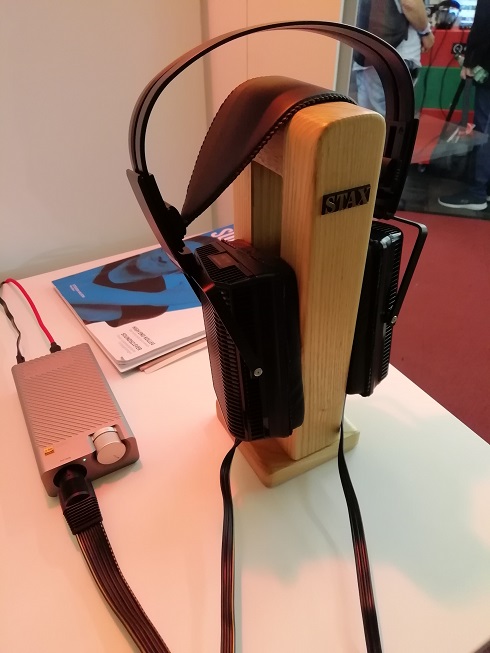
The amplifiers were connected to a streamer, commanded via a touchpad;
actually, each of the headphones/amplifier combos exhibited in Stax's booth
was connected to a streamer, each connected to the same network and pointing
to the same music server, commanded by that same touchpad, so that you could
switch between headphones while listening to the exact same song. A nice way
to make you taste the differences among the models, and a very confident
move - they are not afraid that people could perceive little or no
difference to justify the more expensive models.
The anglo-portuguese Innuos exhibited a
more expensive, but also more contemporary system, consisting of
their ZEN Mk3 1Tb server/streamer and a pair of the acclaimed LS
50 wireless active loudspeakers by KEF that, unlike their diminutiive
size could tell, easy filled the room with sound. Power, USB and network
cabling was included in the price of Eur 4.811.
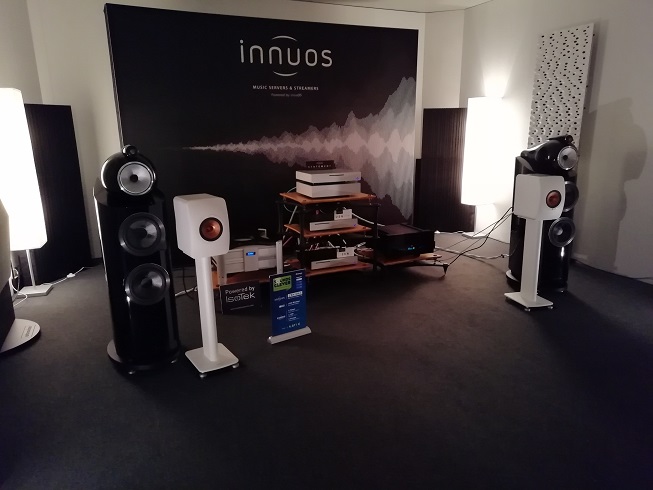
DALI assembled a system for Eur
4.376, consisting of their Oberon 7 2-way floorstanding loudspeakers
driven by the newest M10 BluOS streaming amplifier by sibling
company NAD, plus Dali's basic
RM 230 C loudspeaker cable. Stylish, compact and technologically
updated. I cannot tell you much about its sound, due to a noisy room, but,
as far as I could tell from such a listening experience, its sound seemed to
me quite balanced, sometimes a little harsh, but, again, I couldn't tell
what files were being played, and people around were far from silent.
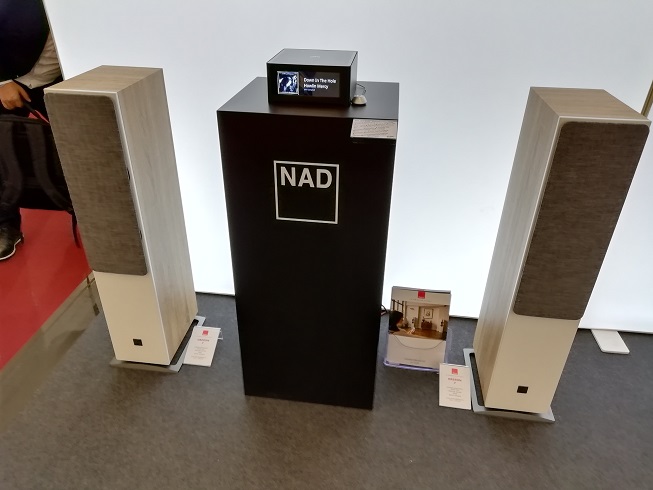
Cocktail Audio proposed a system
consisting of just its X-45 1 TB ripper/server/streamer (it also
sports MM phono input, line input, RCA and XLR audio output, features a
double Sabre ES 9018QM DAC, and so on...) and Nubert's nuPro X-6000 active
floorstander loudspeakers. All this, plus XLR cables and a power bar, both
by German manufacturer In-Akustik, for Eur 4.780
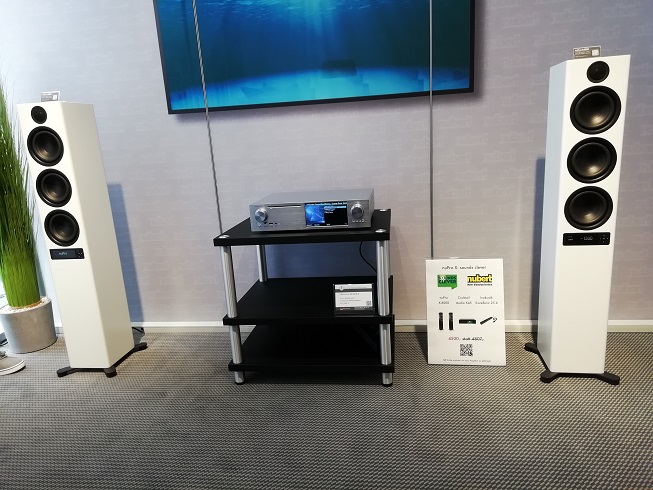
Other musings and ramblings
I noticed a flourishing of "all-in-one" solutions that squeeze
lots of functions directly in the loudspeakers, once thought as the system's
last end and now including the whole system in it. I saw several of them
around the show, but I was particularly intrigued by KEF's deminutive LSX
active (DSP-driven) loudspeakers that can accept digital input signals
either wired (ethernet, toslink), or wireless (Bluetooth Apt-X, Airplay2),
can stream music from the web (Spotify and Tidal) or from your local storage
(DLNA), can work with Roon, etc. During the demo, Kef's Johan Coorg
commanded the loudspeakers via its smartwatch, and showed me that the whole
system included also another pair of LSXs in the adjacent room that could
also play the same music and still be perfectly synced, although being
completely wirelessly connected: no latency (actually, a bunch of
microseconds, Coorg said - I guess well under my ears and brain resolution
abilities). As usual, Kef's exhibited system consisted also of one of their
big traditional passive tower models, yet the little LSXes still managed to
fill the room with sound, albeit, of course, not as full and extended.
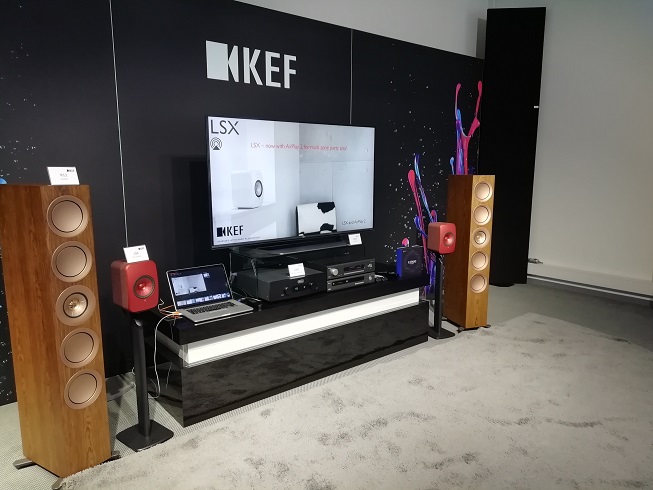
Another thing I noticed this year was that the exhibitors proposed lots of
theme-based features, especially tightly scheduled illustrated demos of
their products, with people not just playing music, but also illustrating
how the products have been thought, designed and made, what were the
consumer needs the company aimed at, etc. I think this is a great way to go,
because it can engage the show attendee more than a simple product showcase.
Yet, many (almost all) of those interesting demonstrations were held in
German, and only when I could make a direct and personal conversation with
the - always very kind - brand reps I could speak English and understand
what was being said before; but it was not so effective and, above all, it
was time consuming for both of us.
Now, I understand that it is my fault not to know my guest's own
language.
But, being this show the world reference for the industry, I anyway expected
some (okay, most) of the demos to be held at least alternating those in
German with those in English. It surely would have helped visitors coming
from the USA or the UK, and from all of those places where international
business are usually conducted in English, like eastern countries. This is
something I noticed only this year, since in my past visits to the show, I
could easily follow lots of demos, held in English.
Of course, exhibitors must have thought carefully about also this aspect of
their presence at the show, and it's natural that they want to satisfy their
more direct consumers, their internal market. Yet, I think that this aspect
was one of the very few - the only one, I'd say - that I would have changed.
I'm writing this mainly because it was something that dimmed from the inside
the international relevance of the show, something really contrastating with
the role of this show as the international reference for this specialist
industry. It's like we wanted to put up an international show in Italy and
held the demos only in Italian: everybody would notice how incongruent this
behaviour would be, since or language is very little known and used outside
our peninsula and your opera houses :-)
Pit stop
Well, I think that this can be enough for a "first part". As
usual, other part(s) will follow, with less chatter and more pictures.

© Copyright 2019 Carlo Iaccarino - www.tnt-audio.com
[ Home | Staff &
Contacts | HiFi Playground |
Listening tests | DIY & Tweakings | Music & Books ]














